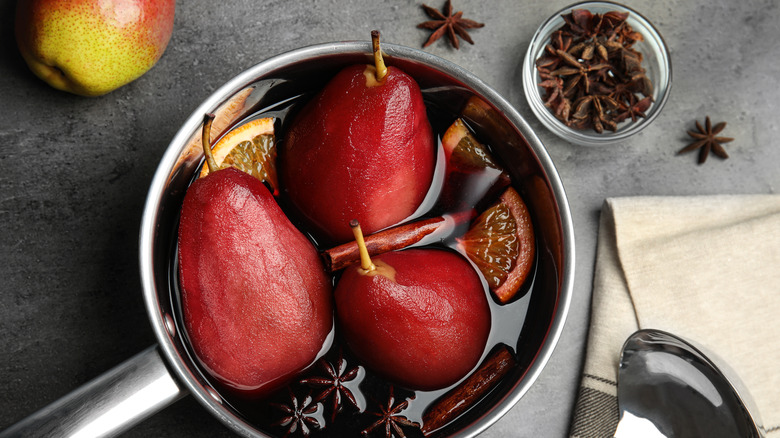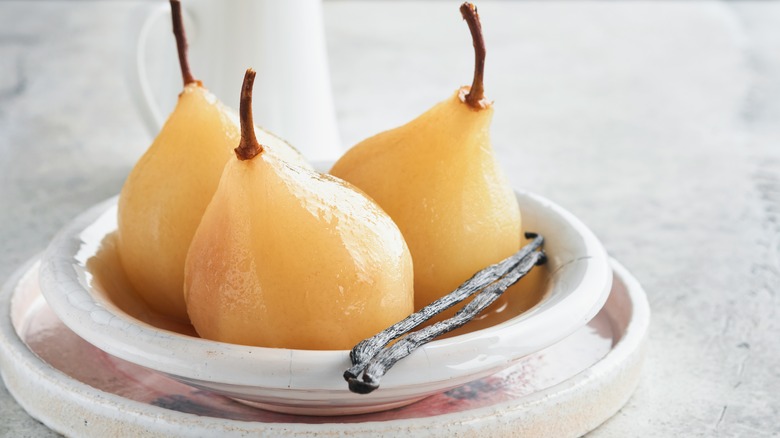The Tip To Live By For The Most Flavorful Poached Fruit
When it comes to fruit-based desserts, you don't always have to fall back on pies and pastries that just feature fruity filling — sometimes it's enough to let the produce itself be the star of the show. And that doesn't mean just slicing up some strawberries and setting them on a plate with whipped cream. One of the easiest ways to give fruit the center stage on the dessert table is to poach it.
Poaching starts with cut, halved, or whole fruit (depending on your pick and the look you're going for) that's then simmered in a mixture of slightly sweet liquids like wine, sugar, and spices, until it's cooked through. The whole process is quite simple, and since the cooking process lets most fruits maintain their shape, the resulting poached pears, apples, figs, or otherwise are an elegant centerpiece.
This method isn't all about the aesthetics, however; it also enhances and amplifies fruit's natural sweetness and imparts aromatic flavor from the liquid used. Even though those flavors will come through as the fruit simmers on the stovetop, the secret to intensifying the taste is not to remove the fruit from the liquid right away when it's done cooking. If you allow your fruit to cool in the poaching liquid until it reaches room temperature (around 20 minutes), it will continue to absorb the syrup's flavor, leaving you with a sweet, bright, and vivid dessert every time.
Ripeness matters when poaching fruit
This final steeping step not only realizes poached fruit's flavor potential, but also helps with texture — but you'll want to be sure to use produce at the right level of ripeness. Selecting firm and slightly under-ripe fruits is usually your best bet for this dish because simmering them in the poaching liquid will soften them quickly. So you'll need fruit that can stand up to the cooking process. Riper fruits already start out on the softer side, so once they're cooked for a longer length of time, they may just fall apart rather than maintaining their shape.
However, under-ripe fruits also have a weaker flavor, so even though the texture will be right, they'll need help in the taste department. Allowing them to absorb the poaching liquid post-cooking will combat some of this lack of sweetness.
You can still work with ripe or less firm fruit, but make sure to adjust the cooking time to be significantly less so the fruit doesn't end up mushy. Riper fruit will also be naturally sweeter, so you'll want to adjust the added sugar in the liquid to account for the flavor difference.
There's more than one way to cook fruit
Poaching fruit is an easy way to take your desserts or even your morning yogurt to the next level, but it's not the only option when raw fruit just won't cut it. Roasting fruit is another delicious choice, and a simple one, too — fruit releases its juices while it cooks and caramelizes, so its flavor will be elevated when heat is applied. Plus, hardly any additional ingredients are needed. If you want to save time and any mess, you can even roast fruit in the air fryer.
When summertime rolls around, there's no better time to experiment with cooking fruit on the grill. Doing so will start to caramelize the fruit's juices, intensify the flavor, and even give off a smokiness that pairs perfectly with the sweetness. Even if you want to grill fruit but don't have a grill — or the weather just isn't cooperating — you can still get the flavor and texture benefits by using a grill pan or broiling fruit in the oven.


